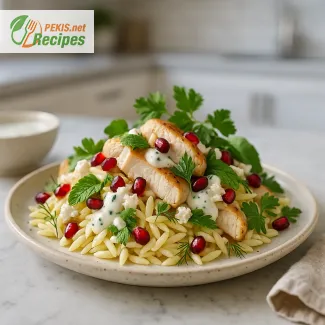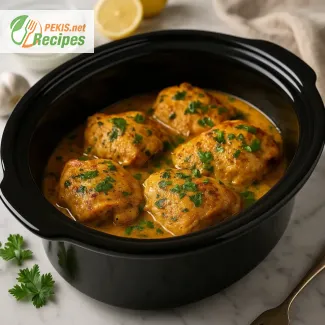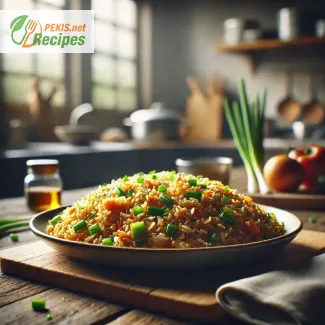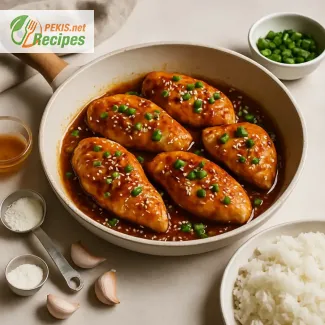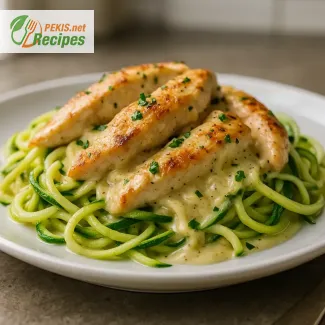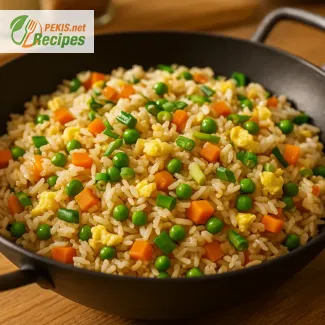
Master the Art of Homemade Fried Rice in Minutes
Discover the secrets behind perfectly cooked rice, bold flavors, and quick preparation
When you're craving something savory, quick, and deeply satisfying, few dishes can rival a well-prepared fried rice. This globally beloved comfort food has evolved from a simple way to use up leftovers into a versatile, flavor-packed staple that's a star on any dinner table. Whether you're cooking for one or feeding a family, a homemade fried rice dish delivers on taste, texture, and speed — making it an essential addition to your weeknight meal rotation.
Originating from ancient China and embraced across countless cultures, fried rice has become a canvas for culinary creativity. From traditional Chinese-style fried rice to Thai, Indonesian, and even Americanized versions, the dish's adaptability is a major part of its universal appeal. At its heart, it’s all about transforming cold, day-old rice into a warm, umami-rich meal layered with savory notes, fresh vegetables, and optional proteins.
Why fried rice belongs in every home cook’s repertoire
At a time when convenience is crucial but health and flavor still matter, fried rice strikes the perfect balance. It’s a one-pan meal that’s economical, easy to customize, and lightning-fast to prepare. This makes it an excellent choice for both beginner cooks and seasoned kitchen pros looking to whip up something delicious with minimal effort.
What makes this fried rice recipe stand out is its clarity in method, careful layering of flavors, and the strategic use of ingredients like toasted sesame oil, soy sauce, and aromatic vegetables that elevate it well above a basic rice stir-fry. Whether you’re repurposing cooked rice from a previous meal or intentionally prepping ahead to achieve that ideal texture, this recipe is built to maximize flavor without sacrificing simplicity.
What makes the perfect fried rice?
Perfect fried rice starts with the right type of rice — long-grain varieties like jasmine or basmati work beautifully because they stay separate when stir-fried. Using cold, refrigerated rice is key. Freshly cooked rice tends to be too moist, which can lead to a mushy dish. When properly chilled, the grains firm up and fry evenly, soaking up flavors while retaining their shape and bite.
A truly flavorful fried rice also relies on the right aromatics and seasonings. Garlic, ginger, and scallions form the aromatic foundation, while soy sauce adds depth and a touch of saltiness. A splash of sesame oil at the end imparts a toasty finish, and a quick toss of scrambled eggs, peas, and carrots adds color, protein, and balance. You can also fold in chicken, shrimp, tofu, or even leftover roast meats for a heartier version.
Key techniques for restaurant-quality results at home
A high-heat wok or skillet is essential for that signature wok hei — the slightly smoky, seared flavor you find in restaurant-style fried rice. The goal is to cook quickly, stirring constantly but deliberately. Ingredients should be added in stages: aromatics first, then vegetables, rice, and sauces. This layering approach ensures every component is well-cooked and flavorful, rather than steamed or soggy.
One of the most common mistakes home cooks make is overcrowding the pan. For best results, cook in batches if necessary. This allows the rice to actually fry rather than steam, giving it those lightly crispy edges and toasty flavor.
Another secret lies in the final seasoning. Taste and adjust before serving. A dash of white pepper, a sprinkle of chili flakes, or a spoonful of oyster sauce can be the finishing touch that brings the dish to life.
Versatility and variations across cuisines
One of the best things about fried rice is how well it adapts to what's already in your kitchen. Got some frozen vegetables? Toss them in. Leftover grilled chicken? Shred it and stir it through. Craving something spicy? Add chopped chili or a spoon of sriracha. You can take this core recipe and adapt it to Korean kimchi fried rice, Hawaiian spam fried rice, Thai pineapple fried rice, or even vegetarian and vegan versions packed with seasonal greens and plant-based proteins.
Because the recipe is so flexible, it's perfect for all kinds of diets and preferences. And since it requires just a handful of pantry staples and 15–20 minutes of cook time, it’s also a lifesaver on busy weekdays or after late work hours when takeout feels like the only option.
Common mistakes and how to avoid them
The road to perfect fried rice is paved with a few common pitfalls, but once you know what to avoid, success is inevitable:
- Using freshly cooked rice: Always chill the rice for at least a few hours or overnight to prevent clumping.
- Not using enough heat: A very hot pan is crucial for achieving texture and depth.
- Overloading the pan: Give ingredients room to fry, not steam.
- Skipping the aromatics: Garlic, ginger, and green onions are small but mighty flavor builders.
- Adding soy sauce too early: Wait until the rice is heated through so the sauce doesn't overly moisten the grains.
These small tweaks make a huge difference in the final result.
The flavor profile: balance, umami, and crunch
A well-executed fried rice should hit all the right notes: savory, slightly salty, subtly sweet, and packed with umami. The bite of fresh vegetables, the richness of egg or meat, and the aroma of sesame oil or soy sauce combine into a multidimensional flavor experience. Texture also matters — the rice should be fluffy yet slightly crisp at the edges, and the vegetables tender but still vibrant.
Each ingredient plays a specific role. Eggs bring creaminess and protein. Peas and carrots add color and subtle sweetness. Green onions add freshness, while soy sauce and white pepper lend depth. The result is not just a convenient meal, but a truly crave-worthy one that you'll want to make again and again.
Fried rice as an everyday essential
Because it’s endlessly adaptable and always satisfying, fried rice is more than just a backup dinner plan — it’s a cornerstone of home cooking. It’s economical, sustainable (perfect for reducing food waste), and culturally rich, offering a taste of global culinary traditions all in one pan.
Whether you’re just learning how to cook or you’ve got years of stir-frying experience, this recipe will quickly become a go-to favorite. You'll appreciate the speed, your guests will appreciate the flavor, and your leftovers will never be the same again.
- Prepare the ingredients: Make sure the rice is cold and dry (ideally prepared the day before). Dice the carrots finely, slice the scallions, mince the garlic, and grate the fresh ginger. Beat the eggs in a small bowl and set aside.
- Cook the eggs: Heat a large non-stick skillet or wok over medium-high heat. Add 5 ml (1 tsp) sunflower oil and pour in the beaten eggs. Stir gently until just cooked and soft-scrambled. Remove from the pan and set aside.
- Sauté vegetables: Add remaining sunflower oil to the same pan. Add garlic and ginger, stir for 30 seconds until fragrant. Add diced carrots and cook for 2–3 minutes until tender. Stir in peas and cook for another minute.
- Add rice: Increase heat to high. Add the cold rice and break apart any clumps. Stir-fry for 4–5 minutes, pressing gently and flipping the rice to toast evenly.
- Season: Add soy sauce, salt, and white pepper. Toss thoroughly until evenly coated.
- Combine all: Return scrambled eggs to the pan along with sliced scallions and sesame oil. Stir-fry everything for another 1–2 minutes until hot.
- Serve hot: Plate immediately and serve as a main or side dish.
Enhance Your Fried Rice Experience with Pro-Level Tweaks
Transform everyday ingredients into a restaurant-worthy fried rice
Creating the perfect fried rice at home is more than just tossing cold rice in a pan. While the base recipe delivers bold flavor and satisfying texture, there’s a lot of room for improvement — and experimentation. From nutritional upgrades to flavor enhancements, small changes can elevate this humble dish into something memorable. Whether you’re cooking for health, indulgence, or innovation, the right techniques and ingredients make all the difference.
Unlocking deeper flavors with small ingredient changes
Adding just one or two new elements can dramatically alter the flavor profile. For instance, swapping regular soy sauce with dark soy sauce gives your fried rice a richer color and a more robust, almost molasses-like depth. A touch of fish sauce can provide an umami punch, though it should be used sparingly to avoid overpowering the dish.
For a more aromatic twist, try stir-frying the aromatics in ghee or clarified butter instead of vegetable oil. This adds a nutty complexity that works especially well when paired with proteins like shrimp or chicken.
Another pro tip: replace frozen peas with edamame for a boost in protein and a firmer bite. Or toss in finely shredded cabbage or bok choy in the final two minutes of cooking to add a crunchy, fresh texture without altering the core flavor.
Spice and heat: creating personalized flavor profiles
One of the easiest ways to customize fried rice is by adjusting its heat level. If you prefer a mild spice, add a sprinkle of white pepper or use a bit of freshly grated ginger for warmth. For a spicier version, stir in chili oil, crushed red pepper flakes, or diced Thai bird’s eye chilies during the sauté stage.
You can also explore regional variations by incorporating different spice blends. Add a pinch of curry powder for an Indian-style fried rice or a dash of five-spice powder for a Chinese twist. Each adjustment brings out a new dimension, allowing your fried rice to adapt to various culinary traditions.
Upgrading the protein for a more satisfying meal
The original version uses eggs as the main protein, but you can easily enhance this with additions like grilled chicken, roasted pork, or pan-seared tofu. Each option alters the flavor and texture dramatically:
- Chicken breast or thigh: Adds moisture and pairs well with garlic and soy.
- Shrimp: Brings sweetness and umami; best cooked separately then stirred in.
- Firm tofu: Keeps the dish vegetarian and soaks up flavor beautifully when marinated first.
By including multiple proteins — such as egg and shrimp or tofu and chicken — you create a more layered and complete dish that serves as a full main course rather than a side.
Avoiding common mistakes in fried rice preparation
Even experienced cooks can make errors that compromise the final dish. One of the biggest pitfalls is using freshly cooked rice, which results in a mushy or clumped texture. Always use rice that’s been cooled and stored in the refrigerator for at least 4–6 hours. This allows excess moisture to evaporate and the grains to firm up.
Another mistake is overcrowding the pan. Too many ingredients in the skillet lower the heat and cause the rice to steam instead of fry, robbing it of that desirable crispness. Cook in smaller batches if necessary and use a wide pan to maximize surface area.
Finally, don’t underestimate the impact of seasoning timing. Add soy sauce and other liquids only after the rice is heated through to prevent sogginess, and always taste before serving to fine-tune the balance of saltiness, sweetness, and spice.
Healthier substitutions without compromising flavor
If you’re looking for a lower-calorie or more nutrient-dense version, try swapping white rice for brown rice or cauliflower rice. Brown rice brings additional fiber and a slightly nutty taste, while cauliflower rice slashes carbs and adds a gentle earthiness.
Another health-conscious substitution is replacing scrambled eggs with egg whites, which still add protein but reduce cholesterol and fat content. For added nutrients, stir in a handful of chopped spinach, zucchini, or kale during the last minute of cooking. These vegetables cook quickly and blend seamlessly into the dish without overwhelming it.
Use low-sodium soy sauce to control sodium intake, and opt for avocado oil instead of vegetable oil for its healthy fat profile and neutral taste.
Why homemade fried rice always tastes better
Store-bought or restaurant fried rice often comes with excess oil, added sugar, and sometimes artificial flavor enhancers. When you make it at home, you control the quality of the ingredients, the type of oil, and the level of seasoning. This not only makes it healthier, but also more satisfying, as you can tailor every element to suit your taste and dietary needs.
Additionally, cooking fried rice at home allows you to use up leftovers creatively — from cooked meats and vegetables to scraps of herbs or even fruit like pineapple, which adds a tropical, sweet-savory contrast when diced and folded in at the end.
Make-ahead and meal prep potential
Fried rice is also an excellent meal prep dish. You can cook the base rice in advance, pre-chop vegetables, and even portion out sauces. When it’s time to eat, everything comes together in under 10 minutes, making it ideal for busy weeknights or quick lunches.
You can also freeze portions in airtight containers. Reheat directly in a pan with a splash of water or broth to restore moisture and revive texture — far better than any microwaved takeaway.
Unexpected additions for a gourmet touch
Looking to go beyond basic? Incorporate truffle oil in the final seconds of cooking for an upscale twist. Add crushed roasted peanuts or cashews for crunch. Stir in a spoonful of miso paste for a savory umami bomb. Even a poached egg on top can turn a humble bowl of fried rice into a restaurant-style plate.
With just a bit of creativity and attention to detail, this everyday classic becomes a signature dish worth repeating and reinventing again and again.
Allergens present in the recipe:
- Eggs
- Soy (from soy sauce)
- Gluten (from standard soy sauce)
Tips to replace allergens and gluten:
- Eggs: Replace with crumbled tofu or chickpea flour scramble for egg-free version.
- Soy sauce: Use gluten-free tamari or coconut aminos.
- Gluten: Ensure tamari is labeled gluten-free; verify all sauces and flavorings.
Vitamins and minerals per serving (approximate):
- Vitamin A: 3200 IU – supports vision and immune function
- Vitamin B6: 0.3 mg – helps in brain development and immune system health
- Vitamin C: 6 mg – boosts immune defense and antioxidant activity
- Vitamin E: 1.5 mg – protects cells from oxidative stress
- Folate: 60 µg – important for red blood cell formation
- Iron: 1.5 mg – supports oxygen transport in the blood
- Magnesium: 38 mg – essential for muscle and nerve function
- Potassium: 260 mg – regulates fluid balance and nerve signals
- Zinc: 0.9 mg – promotes wound healing and immune support
Antioxidants per serving (approximate):
- Beta-carotene: 1700 µg – converted into vitamin A for immune health
- Lutein + Zeaxanthin: 150 µg – support eye health and prevent oxidative damage
- Selenium: 8 µg – contributes to antioxidant defense and thyroid function
- Manganese: 0.8 mg – aids in metabolism and protects against free radicals
